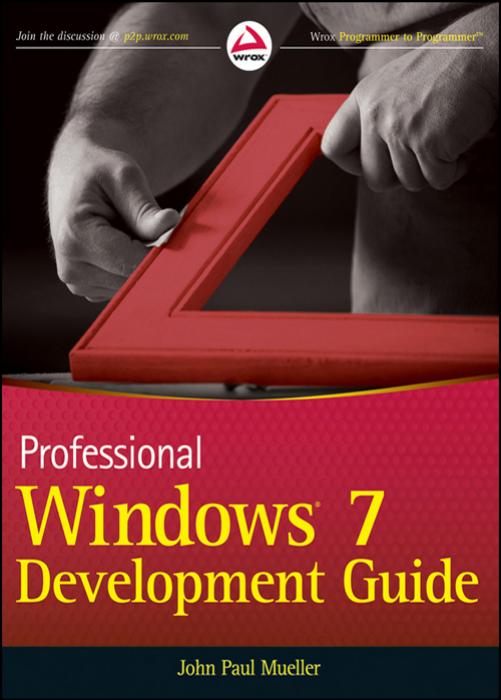Professional Windows 7 Development Guide by John Paul Mueller

Author:John Paul Mueller
Language: eng
Format: epub, pdf
Publisher: Wiley
Published: 2011-01-04T16:00:00+00:00
// Create a membership condition check.
ZoneMembershipCondition ZoneMember;
ZoneMember = new ZoneMembershipCondition(SecurityZone.MyComputer);
// Check for application directory membership.
if (ZoneMember.Check(EV))
MessageBox.Show("Assembly is a member.");
else
MessageBox.Show("Assembly doesn't belong.");
}
The code begins by accessing the assembly to get the evidence needed for this check. The example gains access to the current assembly using the GetExecutingAssembly() method. However, you could also use calls such as LoadAssembly() to load an external assembly.
Once the code has access to the assembly, it uses the Evidence property to get all the evidence for the assembly. Most assemblies support four kinds of evidence as a minimum: Zone, URL, StrongName, and Hash.
This code checks for Zone class membership using the ZoneMembershipCondition object ZoneMember. As part of creating ZoneMember, you must define the SecurityZone enumeration member to check.
The Check() method returns a simple Boolean value indicating whether the assembly is part of the specified class, which is SecurityZone.MyComputer in this case. Because you’re executing this program from your desktop, the check likely passes in this case. However, if you were to check for some other zone, the check would fail. Note that checking membership doesn’t generate a permission object — all this check does is tell you when an assembly has a particular membership.
Developing for Security Roles
Role-Based Security asks the question of whether some entity (a user, the system, a program) is in a particular role. If it’s in that role, the entity can likely access a system resource or application feature safely. The concept of a role is different from something more absolute like a group. When you’re a member of a group, you have the same access whether you access the system from a local machine or the Internet. A role does include the idea of group membership, but this is membership based on the environment — the kind of access requested in a given situation from a specific location. An entity’s security role changes, rather than being absolute. The following sections describe how to check a user’s role based on the evidence presented by the application’s current domain.
Configuring the Security Role Example
This example begins with a Windows Forms application. You add a Test button (btnTest). In addition, you need to add the following using statements:
using System.Security.Principal;
using System.Threading;
Download
Professional Windows 7 Development Guide by John Paul Mueller.pdf
This site does not store any files on its server. We only index and link to content provided by other sites. Please contact the content providers to delete copyright contents if any and email us, we'll remove relevant links or contents immediately.
Grails in Action by Glen Smith Peter Ledbrook(9163)
Sass and Compass in Action by Wynn Netherland Nathan Weizenbaum Chris Eppstein Brandon Mathis(8808)
Azure Containers Explained by Wesley Haakman & Richard Hooper(7440)
Configuring Windows Server Hybrid Advanced Services Exam Ref AZ-801 by Chris Gill(7431)
Kotlin in Action by Dmitry Jemerov(7263)
Running Windows Containers on AWS by Marcio Morales(6980)
Microsoft 365 Identity and Services Exam Guide MS-100 by Aaron Guilmette(5399)
Microsoft Cybersecurity Architect Exam Ref SC-100 by Dwayne Natwick(5208)
Combating Crime on the Dark Web by Nearchos Nearchou(4978)
The Ruby Workshop by Akshat Paul Peter Philips Dániel Szabó and Cheyne Wallace(4667)
Management Strategies for the Cloud Revolution: How Cloud Computing Is Transforming Business and Why You Can't Afford to Be Left Behind by Charles Babcock(4527)
Python for Security and Networking - Third Edition by José Manuel Ortega(4232)
The Age of Surveillance Capitalism by Shoshana Zuboff(4209)
Learn Wireshark by Lisa Bock(4114)
The Ultimate Docker Container Book by Schenker Gabriel N.;(3886)
Learn Windows PowerShell in a Month of Lunches by Don Jones(3681)
DevSecOps in Practice with VMware Tanzu by Parth Pandit & Robert Hardt(3565)
Windows Ransomware Detection and Protection by Marius Sandbu(3540)
Blockchain Basics by Daniel Drescher(3507)
